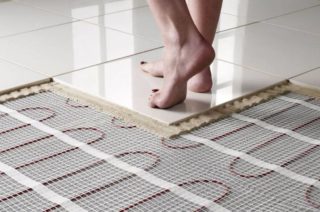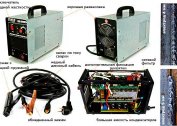The pleasant floor temperature underfoot relaxes and creates a feeling of comfort. But in order for the floor heater to be effective, materials with high thermal conductivity are selected for the finish of the floor. Porcelain tile for a heat-insulated floor - an admissible option.
Characteristics of porcelain stoneware
Porcelain tile is a type of ceramic. Illite clays, kaolin, quartz, feldspar are mixed, press powder is obtained from raw materials, tiles are formed by pressing and dried. At this stage, products glaze, apply drawings. Then the material is fired at + 1200–1300 C, polished or polished.
The material obtained using this technology significantly exceeds conventional ceramics in terms of strength, hardness, smoothness and other indicators:
- Bending strength is higher than that of granite, 3 times - 500-600 kg / cubic cm. Mohs hardness reaches 7-8 - according to this indicator, the material is second only to rubies and diamonds. Damaging the tiles is extremely difficult. Due to the high strength, a material thicker than 1 cm cannot be sawed with a hand tool;
- High resistance to wear - 3-5 class. In the bathroom or bedroom, traces of abrasion on class 3 tiles will never appear, since the material is designed for a heavy load.
- Extremely low water absorption - 0.01–0.5%. Porcelain tiles are faced in bathrooms, bathrooms, Turkish baths, pools.
- Frost resistance - associated with low porosity of the material. If moisture does not get inside the stone, frost is not terrible. This is an important advantage for a ventilated frame facade and for open balconies.
- Porcelain stoneware is chemically neutral. Does not absorb dyes, does not interact with acids, alkalis, salts, is not contaminated.
- Plates imitate natural stone, wood and even leather. The color scheme is unlimited. With the help of different processing, different textures are obtained: matte, glossy, embossed, polished, laplated.
The disadvantage of porcelain is expensive repair. With a leak, a sensor failure, any other breakdown, the finish must be removed. It is almost impossible to completely dismantle the slabs: you have to remove the cover and re-lay it.
Floor slabs are produced with a thickness of 12 to 30 mm. The thicker the porcelain tiles, the greater the load it can withstand, but the worse it conducts heat. Only thin material is suitable for finishing a warm floor.
Nuances that affect the choice of a warm floor
The effectiveness of the floor heater depends on the characteristics of the heating system and the performance of the finishing material. The peculiarity of porcelain stoneware is good heat conductivity, but low ability to accumulate. The stoves heat up and cool at the same speed as the heater heats up and cools.
This feature determines the choice of a warm floor.
- If the granite is laid on a cable underfloor heating, both components of the heater work as a unit. If you install an electronic thermostat, you can adjust the temperature to the nearest degree. Using the instructions, they create a heating mode: during the day, when no one is at home, lower the temperature, increase in the evening. By reducing the temperature by only 1 degree, they reduce electricity costs by 5%.
- IR film heats objects and objects in a room faster than the floor itself. Often, the tile remains barely warm to the touch. If the floor heater is used as additional heating, this option is unsuccessful.
- The warm water floor heats up slowly, but also cools at the same rate.Porcelain tile also maintains a pleasant temperature. This model is more economical: warming up for a couple of hours ensures a comfortable temperature for the next 10 hours. However, it takes time to warm up the room.
Take into account technical capabilities. It is difficult to build a water floor during repair in an apartment. Installing IR film without a screed will require minimal measurements and time.
Underfloor heating power
The thermal conductivity of the material leaves 1.05 W / m * K. This is enough to transfer heat from the heating elements of the floor surface. The effectiveness of a warm floor depends on the thickness of the screed and operating conditions:
- If the thickness of the screed is more than 50 mm, the floor heater for porcelain tiles will not work - this is a general rule.
- If installing under the screed, two-core heating cables are recommended. For living rooms there is enough power of 140 W, sq. m. When laying on loggias or balconies, power is needed higher - up to 180 W / sq. m
- The power of the infrared floor heating under the porcelain tile is 150 W / sq. m, if it is additional heating, and 220 W / sq. m, if the main thing. In fact, the power may be less. IR film does not heat the floor, but objects and people in the room. But if the porcelain tile should be warm, you need to install a heater more powerful.
Power is selected based on operating conditions. For living rooms, a sufficient indicator is 120 W / sq. m, for loggias - 150 W / sq. m. In rooms with high humidity, a more powerful system is needed - up to 220 W / sq. m
Advantages and disadvantages of underfloor heating under porcelain tile
Considering floor heaters for porcelain tiles, it is rational to divide them into 2 types: water and electric. The device they have is different and the advantages are also different.
The advantages of a water floor heating include:
- Profitability - a floor heater is connected to the heating of a house or apartment, so that the cost of its operation does not exceed the usual cost of heating.
- Pipes are placed in a concrete screed. This material protects the heating elements from mechanical deformation.
- Thermal inertia for living rooms is an advantage. Heating here works cyclically, but does not turn off completely. The smoothness of heating and cooling avoids sudden jumps in temperature. It is not necessary to turn on the heater at full power.
- Water heating does not create an electromagnetic field and does not dry out the air.
The disadvantages are:
- laborious installation and repair;
- initial costs for installing water heating exceed the costs of installing electric 5 times;
- installation on stairs or in small areas is not possible.
Pros of the electric floor:
- The heating rate is noticeably greater. The thermal inertia of the system is low.
- You can precisely control the temperature. A programmable electronic thermostat can reduce heating costs by 40%.
- Uniform heat distribution.
- Installation takes much less time. You can install a warm floor at any time.
The disadvantages are as follows:
- high cost of heating;
- a heater based on a heating cable creates an electromagnetic field and dries the air;
- special installation work is required - grounding, RCD connection.
Repairing any kind of floor heater is complicated and costly. To eliminate the breakdown, dismantle most of the coating, destroy the screed and perform all laying work again.
Comparison of underfloor heating under porcelain tile
Underfloor heating under the porcelain tile can be installed of any type. The choice does not depend on the characteristics of the material and the floor heater, but on the installation conditions.
Water floor
Water floor - the structure is complex. Requires substantial cash investment. The minimum thickness of the concrete screed is 45 mm, not counting the thickness of the hydro and vapor barrier, reinforcing mesh, substrate and other things.Arrangement of a water floor is planned during construction. This is difficult to do in an apartment.
The water floor is recommended to be installed in residential premises and in large areas. The disadvantage is the inability to accurately control the temperature does not allow saving.
Electric
There are several options: heating cable, thermomats, rod heater.
The heating cable is universal. The thickness of the screed does not exceed 50 mm - you will have to raise the floor level by no more than 1 cm. The power of the heater depends on the power of the cable and on how small the pitch is laid. Using the same wire, they organize the optimal heating of different rooms.
Mats are the same cables fixed on the stack. The advantage is the speed of installation. Minus - you can not change the masonry step.
An electric heater is chosen for rooms where fast heating is required. This is a good option for additional heating.
Infrared
If it is no longer possible to raise the floor level, the thinnest option is used - IR film. Lay in a layer of tile adhesive with a thickness of 3-10 mm. An infrared heater is more efficient, but more expensive.
An infrared film generates thermal radiation by heating objects and objects, not the floor, and therefore porcelain tiles feel only slightly warm to the touch.
The best manufacturers of underfloor heating for tiles
In 2019, the ranking of the best manufacturers of floor heaters looks like this:
- Electrolux is a Swedish company. It guarantees the safety of its products and its operation for 50 years.
- Teplolux - a Russian company, offers floor heaters that are easy to install.
- Termo is a good combination of quality and affordable cost.
- Devi - produces a variety of heating systems for any task.
- Nexans - produces the only electric underfloor heating whose official life is 60 years.
When choosing a floor heater, it is better to pay attention to the characteristics of a particular model, and not to the brand.









